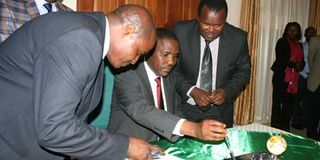Adopting a planning culture can resolve the multiple crises buffeting this country

Meru County Governor Peter Munya (centre) is assisted to sign a copy of the First Meru County Integrated Development Plan 2013-2017 at Three Steers Hotel, Meru on July 22 2014. Politicians must allow our planners to ‘co-drive’ Kenya. PHOTO | PHOEBE OKALL
What you need to know:
- Without a national spatial plan, how has the government been preparing the Orma, Rendille, Samburu, Kore, El-Molo, Borana, Wardei, Pokomo, Dassanech, Gabbra, Ariaal and the Maasai for the fundamental changes bound to take place on their lands once the mega-project becomes a reality?
- Time has come for us to sit around the table, think, talk and dream about a different Kenya – not in the manner suggested by the Cord leadership, but out of a realisation that what we are now facing is a grave existential threat.
Kenya is now at an historical epoch in which it faces a multitude of crises. Some like insecurity are so critical that they pose an existential threat to the country.
For many, the forces at play are what have ‘broken’ other countries in Africa. But we do not have to go that way. We have no option but to use the painful lessons we are learning to make Kenya better.
One way of doing this is by developing and embracing a culture of planning. Doing so requires us to acknowledge that our destiny as a highly disjointed country of 40 million is linked with the fortunes of the geographical entity called Kenya.
Ours is an incoherent collection of interests bound together geographically. We are farmers, politicians, businesspeople, students, ethnic groups, political parties, and so on.
We have private and group interests. But there are also public, national and foreign interests, which place a diversity of conflicting demands on the country.
We are at a point in which balancing all the diverse interests requires defining the middle ground, adopting a give-and-take approach, and accepting some pain so that we can achieve the greater good.
Our leaders must, therefore, do away with the temptation to do things haphazardly. They must replace the traditional way, not with the modern (or Western) style, but with what is appropriate for Kenya.
Politicians must allow our planners to ‘co-drive’ Kenya. Planners must enable politicians to steer the country away from the current pain to self-assurance (which comes with meeting people’s needs).
Again, we cannot do this without the input of planners. Although there are different branches, spatial planning is one branch that we need to bring back to life.
To get there, we must remind top politicians that although they have been pushing so hard to secure their legacy through the implementation of mega-buck projects mooted in the Kibaki era, the projects might eventually fail to achieve their goals if they are not done within the milieu of a national spatial plan.
LOSS OF ECOLOGICAL INTEGRITY
For instance, I am not sure whether the government has considered the full social, ecological, political, cultural and security implications of the Lamu Port South Sudan Ethiopia Transport Corridor (Lapsset) will have on the country.
Without a national spatial plan, how has the government been preparing the Orma, Rendille, Samburu, Kore, El-Molo, Borana, Wardei, Pokomo, Dassanech, Gabbra, Ariaal and the Maasai for the fundamental changes bound to take place on their lands once the mega-project becomes a reality?
Looked at differently, are our top politicians aware that we now have two ‘full-fledged’ entities – Kenya ‘A” (Nairobi, parts of the Coast and Rift Valley, Mount Kenya, Lake and western regions) and Kenya ‘B’ (Upper Eastern, much of the coastal region and North Eastern)?
Are they aware that the split of the two entities sprung from the fundamentally flawed “development” policies pursued since independence?
If it helps, politicians should know that the unfolding grave security and socio-economic scenarios in Kenya ‘A’ and ‘B’ are being compounded by climate change, unplanned land-use changes, decimation of wildlife by poachers, loss of ecological integrity, proliferation of small arms and interference by foreign interests through nice-sounding community-assistance and conservation schemes?
Time has come for us to sit around the table, think, talk and dream about a different Kenya – not in the manner suggested by the Cord leadership, but out of a realisation that what we are now facing is a grave existential threat.
Spatial planners under the auspices of the Kenya Institute of Planners are now inviting Kenyans for such a dialogue. This is because they have realised that the business-as-usual approach to the unfolding situation is not only untenable; it will ultimately lead to perilous consequences.
With this in mind, planners in KIP are inviting Kenyans for a dialogue with a difference; they are asking Kenyans to nurture “a national development discourse” and a “culture of planning” through which we could jointly address the significant challenges the country faces.
Mr Mbaria is a freelance journalist and town planner ([email protected])




